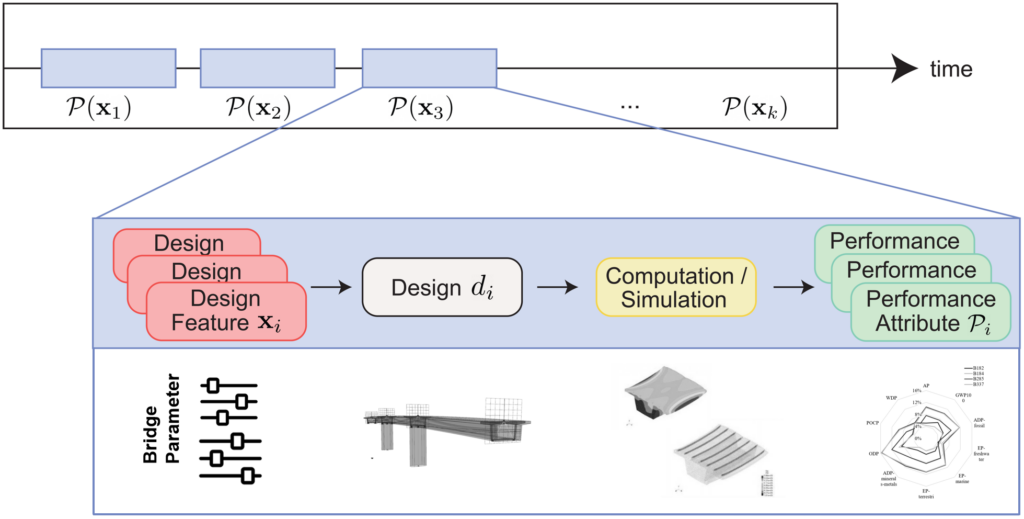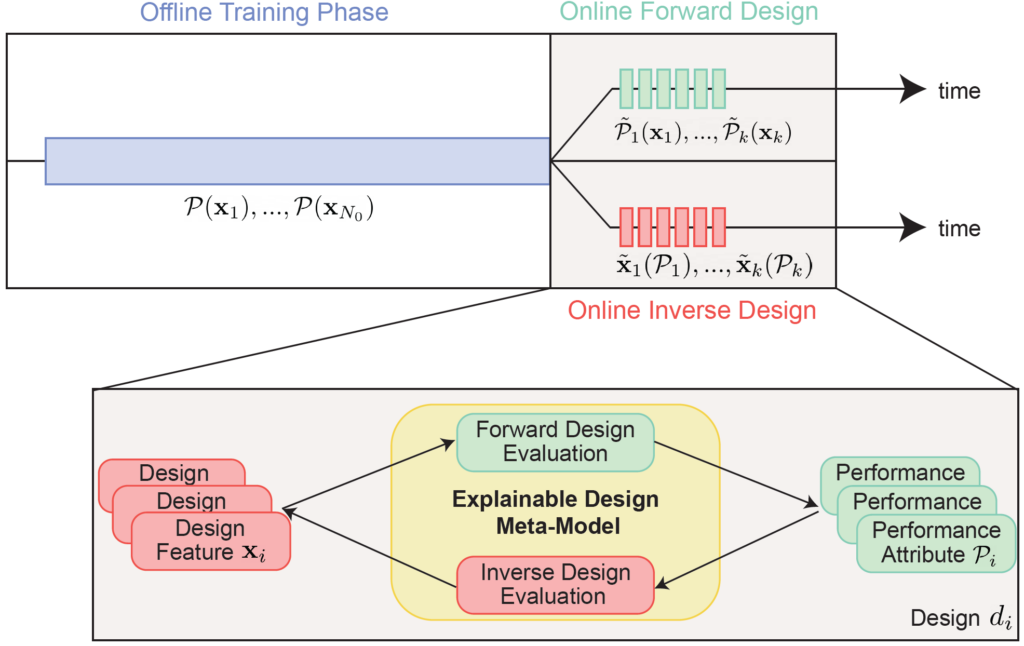Link zu der deutschen Version: Innovation für den Brückenentwurf: Das Potential von KI-gestützter Tragwerksplanung
Bridges are vital infrastructural elements that connect communities, facilitate transportation, and contribute to economic development. The design and construction of bridges require meticulous planning and engineering expertise to ensure safety, efficiency, durability and also aesthetics. So far, this process was heavily reliant on human expertise and manual iterations across multiple teams, resulting in a lengthy and rather rigid design process. Recent advances in artificial intelligence (AI) have already transformed many research and industry fields and have the potential to revolutionize the way engineers conceptualize, analyse, and optimize bridge structures and beyond.
At our Chair, we are working on the integration of modern AI algorithms into structural engineering. Specifically, our ongoing research project “Domain-Aware-AI Augmented Design of Bridge Structures (DAAAD_Bridges)” deals with the implementation of generative AI algorithms for the application in bridge design. Together with the Swiss Data Science Center, we are developing a deep-learning-based software toolbox which aims to function as a co-pilot in early design stages, combining the strengths of AI and humans. Today’s practice is to use simulation software (e.g. finite element software) to evaluate the performance of a specified design. Important design performances include structural safety, serviceability, sustainability, constructability, and cost minimisation. However, detailed and accurate design evaluation via simulation software becomes computationally expensive when applied to complex and high-dimensional design problems such as bridge structures. Using state-of-the-art simulation software renders time-consuming or even infeasible, especially for the case of exploring and comparing multiple design alternatives efficiently in the conceptional design, cf. Figure 1. However, early design decisions are key and performance-decisive for the entire construction project.

We tackle these challenges and reformulate and augment the current design process with data-based insights, cf. Figure 2. We focus on bridge designs allowing for a parametric representation and develop deep-learning models as surrogates for predicting the performance of specified designs (“forward design”), while additionally enabling the generation of high-performing design alternatives conditioned on a set of performance constraints (“inverse design”). Specifically, the forward design model takes design features (e.g. girder height, number of piers, material strength, etc.) as input and then predicts the performances (e.g. structural utilisation, global warming potential, cost, etc.) of the specified design. The inverse model innovatively allows for the generation of a range of design alternatives based on (self-defined) design objectives and constraints (e.g. budget, structural utilisation constraints, clearance height, etc.).

We derived a variant of a conditional variational autoencoder (CVAE), cf. Figure 3, which forms the basis of these design meta-models. The CVAE can be trained on a data set of existing and/or synthetically generated bridge structures. During the training, the model parameter (weights and biases) of the CVAE are fitted to the training data by minimising the loss function defined in Figure 3. The encoder learns the mapping from the euclidean vector x to the corresponding performance vector ŷ (forward design). Simultaneously the decoder learns to generate new design feature vectors x̂ conditioned on the selected performance vector y (inverse design). Subsequent to the training the model is evaluated on a test data set, that consists of bridge structures which the model has not seen before. Additionally, with neural networks being fully differentiable, the CVAE leverages Automatic Differentiation (AD) for the efficient computation of derivatives of the performance metrics w.r.t. the design variables (i.e. for a subsequent local sensitivity or uncertainty analysis.

A pilot study was conducted with Basler & Hofmann, where the developed tools were applied to the project situation of a pedestrian bridge in St. Gallen [2]. Using Dynamo within Revit and SOFiSTiK a data set was generated for the real-life project situation at hand, based on which the CVAE was trained. In the project, we also delivered a first version of a graphical user interface, which facilitates first interactions between bridge engineers and the AI model, cf. Figure 4. It was shown that both the forward and inverse mappings can be learned accurately with our CVAE and its design performance prediction (incl. structural utilisation, material volume and cost), as well as the conditioned design generation, is possible in real-time. The model, therefore, allows for rapid exploration of a large number of design alternatives and to identify optimal designs that meet the given performance objectives. By applying sensitivity analysis the trained models provide an understanding of the dependencies of design features and performances of the high-dimensional design spaces and allow for the derivation of design rules for the analysed structures. The tool can therefore boost key decisions in the conceptual design stage of a construction project and hence promote structures that are characterized by efficiency, economic viability, and environmental sustainability. The limitation is that the set-up of the data generation pipeline, the data generation and the training process itself (i.e. the offline phase, cf. Figure 2) require a considerable amount of time. Therefore, the data-based design models should be as generally applicable as possible, which can be achieved for example by expanding the training database to include multiple project situations and bridge structure types. The study also shows the need and potential for systematic and detailed databases of the planned and built structures of today and to come.

The software toolbox in development is structure-agnostic and can therefore augment a wide range of parametric design problems. We demonstrate the broader applicability of our approach with multiple design application studies: For example the design of steel and timber grid shell structures in cooperation with the Digital Structures group from MIT [3] and the timber connection design with the Timber Structures group from ETH. Sounds interesting? Feel invited to have a look at the project homepages or reach out to us if you are interested to apply our toolbox in your research project or your ongoing project in industry.
Sophia Kuhn
Literatur
| [1] | Kuhn, S. V., Hodel, A., Bischof, R., Balmer, V. M., Pérez-Cruz, F. , Kaufmann, W. , Kraus, M. A. (2023), Assessment and Integration of Sustainability and Circularity Metrics within Generative Bridge Design, EG-ICE 2023, London. |
| [2] | Balmer, V. M., Kuhn, S. V., Bischof, R., Salamanca, L., Kaufmann, W., Pérez-Cruz, F., Kraus, M. A. (2022). “Design Space Exploration and Explanation via Conditional Variational Autoencoders in Meta-Model-Based Conceptual Design of Pedestrian Bridges.” arXiv. https://doi.org/10.48550/arXiv.2211.16406 |
| [3] | Fang, D., Kuhn, S. V., Kaufmann, W., Kraus, M. A., Mueller, C. (2023), Quantifying the influence of continuous and discrete design decisions using sensitivities. Advances in Architectural Geometry 2023, Stuttgart. |
Links
https://mkrausai.github.io/research/01_SciML/01_BH_PedestrianBridge_XAI/